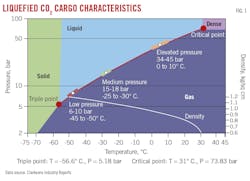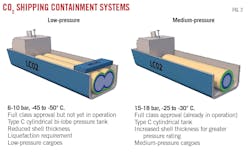Liquefied CO2 shipment requires standardized infrastructure
Elwin Taylor
H. Clarkson & Co. Ltd.
London
The standardization of ship and shore infrastructure is crucial for the rapid development of liquefied CO2 (LCO2) shipping, which is a vital part of the carbon capture and supply (CCS) chain. This article explores how to achieve this standardization.
Background
There are only four very small LCO2 carriers currently in service, and a handful more on order or being built. This raises concerns about whether there will be sufficient vessels to meet the needs of the carbon capture projects requiring marine transportation scheduled to come on stream 2027-30.
Shipowners are hesitant to invest in building LCO2 carriers for a few reasons, mainly because there’s no clear direction from those emitting or sequestering carbon on the specific type or size of ships needed. Questions arise about whether it should be a low-pressure vessel (tanks rated 6-10 bar), a medium-pressure one (15-18 bar), or even an elevated-pressure option (34-45 bar) (Fig. 1). Currently, only medium-pressure ships are operational, but the other types have received full class-approval.
It is easy to imagine a situation in which terminals are designated for different pressure regimes, and ships are built to cater to those specifications. These ships would be dedicated to specific projects throughout their operational lives and would not be free for other tasks. In such a scenario, emitters would face limitations in shipping to different terminals, and sequestration companies aiming to gather volumes from various sources would encounter similar restrictions.
Standardization efforts underway right now aim to streamline temperature and pressure specifications across all proposed project value chains to accelerate market growth by creating a trading market where cargoes move easily from different suppliers to various receiving sites. This, in turn, would encourage the development of new carbon capture projects as emitters would be more confident to greenlight projects knowing there were readily available and accessible storage outlets for their CO2 waste.
LNG lessons
LNG is cited as an example of the sort of technical standardisation and commercial flexibility LCO2 should be modelled on. Despite the majority of LNG moving under specific project conditions today, the first spot cargoes of LNG were not shipped until 1995 (Australia-US), 31 years after non-experimental seaborne movements of LNG began.
Over the years, various designs for LNG transportation have competed with one other. Besides the current Gaztransport and Technigaz (GTT) and Moss Maritime AS designs in service today, historical records show:
- Conch. This design evolved from experimental voyages in 1959 on Methane Pioneer (5,000 cu m). It was used for the original 1964 Arzew, Algeria-Canvey Island trade on Methane Princess and Methane Progress (27,400 cu m), which were fitted with aluminium alloy prismatic cargo tanks.
- Beauvais. Another small experimental vessel (640 cu m, 1962), leading to Jules Verne (25,500 cu m, 1965), which had vertical cylindrical tanks.
- Esso. The company had its own containment system (prismatic aluminium tanks, not dissimilar from Conch) that was used in four 41,000-cu m ships built 1969-70.
- Pythagore. This vessel (630 cu m, 1964) had stainless steel membrane tanks and was the start of the Technigaz system, first used in 1971 for Descartes (50,000 cu m).
- Gaz Transport. A membrane system with invar primary and secondary barriers, this started at scale with Polar Alaska (71,500 cu m) in 1969.
- Euclides. this vessel (4,073 cu m) was the first LNG carrier (but not the first gas carrier) with spherical tanks when it debuted in 1971.
- Norman Lady. This vessel (88,000 cu m) in 1973 featured the first Moss spherical design.
- Polar Eagle. This vessel (87,500 cu m), with IHI Corp. self-supporting prismatic shape International Maritime Organization Type B (SPB) tanks fitted, was yet another innovation in 1993.
Despite their diverse approaches, all these designs shared a common objective: transporting LNG at atmospheric pressure and fully refrigerated temperature. Semi-pressurized LNG carriers with cylindrical or bi-lobe tanks are feasible for small-scale and short-sea applications, with the first one built in 1971 (Melrose, 2,720 cu m). For transporting large volumes over medium to long distances, however, the only practical LNG condition is fully refrigerated, with plants and terminals supplying and receiving cargoes at this temperature. As a result, standardization became a de facto requirement from the outset.
CO2 complications
Standardization, however, is less clear-cut with CO2. Different combinations of temperature and pressure are all theoretically possible for both short- and long-sea trade. While they are not interoperable, they are not so different from one another that it is easy to identify the optimal CO2 carriage design. The decision then hinges on detailed calculations involving capital expenditure (capex) and operating expenditure (opex) trade-offs, with cargo density and economies of scale being important factors.
Vessel dimensions, influenced in part by tank type, also need consideration. Other mitigating factors, such as potential alternative uses for the vessel and its residual value (ability to carry cargoes other than CO2) also play a role in determining the best size and type of vessel.
There is a prevailing idea that every step in the value chain—including liquefaction, shipping, and interim storage—should follow the same pressure specifications. Therefore, if a standardized containment design was to be introduced, the initial selection might be somewhat arbitrary, with the hope that subsequent decisions would naturally follow based on path dependency.
LPG lessons
While less relevant than LNG, it is still interesting to look at the early developments in LPG and petrochemical gas carriers. A brief overview reveals a progression from pressurized-only ships to semi-pressurized and then fully refrigerated types. Excluding the pre-war pioneers, this evolution occurred over 14 years, starting in 1947 (Natalie O. Warren, 6,050 cu m) and extending to 1961 (Gohshu Maru, 11,300 cu m), with Descartes (1958, 920 cu m) marking the introduction of the first semi-refrigerated vessel.
A crucial aspect of this progress is that when new containment systems were introduced, they didn’t replace the existing ones (and the corresponding shore infrastructure). All types continued to evolve. While fully refrigerated transport turned out to be best for long-distance shipping of LPG and ammonia, pressurized ships stayed important for regional trades. Meanwhile, semi-refrigerated vessels found a role in transporting petrochemical gases for both short- and long-distance trade.
Moreover, in the LPG sector, there has been interoperability between the various temperature regimes right from the beginning, with some terminals able to handle both refrigerated and pressurized cargoes.
A fully refrigerated ship, equipped with a reheater, can load cold cargo and discharge it at a higher temperature into pressurized storage, without causing an unacceptable reduction in discharge rate.
For CO2, a low-pressure ship equipped with a cargo reheater could discharge into medium-pressure shore storage, potentially creating a value chain from low pressure to medium pressure. This setup offers greater economy of scale during shipment and interim shore storage at the receiving terminal at a pressure closer to the dense phase needed for pipeline transport to the permanent sequestration site.
However, a problem arises when considering that ship cargo reheaters depend on exchanging heat between warmer seawater and cold cargo, meaning they require a minimum seawater temperature to function. In Northwest Europe during winter, this criterion may not always be met. As such, to ensure year-round operations, a cargo heater with a significantly larger seawater capacity, operating at a lower temperature difference, would be necessary. This has implications for either vessel fuel consumption or shore power supply if shoreside electrical power is used instead of shipborne power.
A conventional semi-refrigerated gas carrier (all low- and medium-pressure CO2 carriers are semi-refs) can leverage its pressure capability to receive warmer cargo and cool it during loading and transit. When transferring across a large temperature-pressure range, however, this process becomes both slow and expensive in terms of the fuel needed to operate the refrigeration equipment. Therefore, loading CO2 at medium pressure and discharging at low pressure is not a realistic option, and in any case, such a value chain would result in an overall pressure regime moving in the wrong direction.
Vessel flexibility
Another way to achieve operational flexibility is by insulating the hold space of an elevated-pressure ship, allowing the transportation of cargo at medium pressure. This type of ship could be exclusively dedicated to either of the two relevant pressure regimes. Alternatively, in theory, it could load at medium pressure and unload at elevated pressure, moving through the value chain towards the high pressure needed for pipeline injection. However, loading at low pressure would be restricted unless the equipment was located onshore.
The same observation naturally extends to the possibility of transitioning between low pressure and medium pressure. Indeed, the key to achieving interoperability may not solely rest with the ships but rather with the terminals’ readiness to invest in the flexibility needed to accommodate different pressure regimes.
It’s worth considering the option of a ship with tanks capable of loading at either low or medium pressure. Such a vessel could be assigned to service in either of the value chains. This would, however, involve building tanks with a specification of -50° C. and 18 bar. While not technically impossible, the nickel steel required for the lower temperature would significantly increase the cost compared with a conventional medium-pressure tank rated, for instance, to -30° C. (Fig. 2), which is already more expensive than a low-pressure solution. While this route might theoretically be feasible for a speculative build, it’s hard to see it making economic sense.
But dismissing the commercial insights gained from other liquefied gases would be a mistake. Unlike LNG, the LPG market has always been open, with shipping and trading closely linked. Only a minority of vessels have been constructed for time charter, and even then, rarely for periods exceeding 5 years. The willingness of owners to invest in CO2 tonnage independently could be seen as desirable by potential CO2 charterers. If ships are to be built speculatively, however, owners must have confidence that the appropriate shore infrastructure will be available to accommodate them. Overlooking this aspect of development could lead to difficulties.
Shore flexibility
If the goal is to achieve standardization for a more adaptable distribution process, it might be more effective to have a variety of regimes in place for both receiving and exporting infrastructure (instead of restricting both ship and shore to a single type), requiring individual sites to be capable of handling both low- and medium-pressure cargoes. This can be achieved either through separate tanks and systems or by using shore conditioning equipment, such as heat exchangers and low- and high-pressure pumps.
Shore flexibility comes at a cost, however, which when handling a negative-value material is not ideal. But the alternative is to restrict interoperability. That would mean building ships dedicated to specific trades for the entirety of their operational lives. While this may turn out to be the model for CO2, it also means giving up on the idea of a flexible shipping pattern, at least in the short to medium term.
Among a small handful of northern European, North Sea-facing CO2 terminal projects advanced enough to be considering this decision, at least one is planning to invest in the flexibility to condition low-pressure cargoes into medium-pressure storage. For larger vessels trading over longer distances low-pressure will almost certainly be optimal. The ability to receive low-pressure cargoes could widen the sourcing of emissions Europe could sequester, taking any eventual European ‘hub’ from a regional to a global option.

